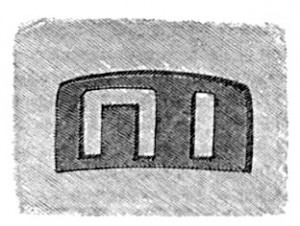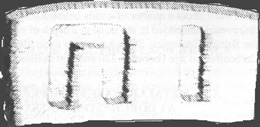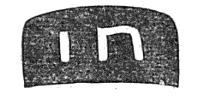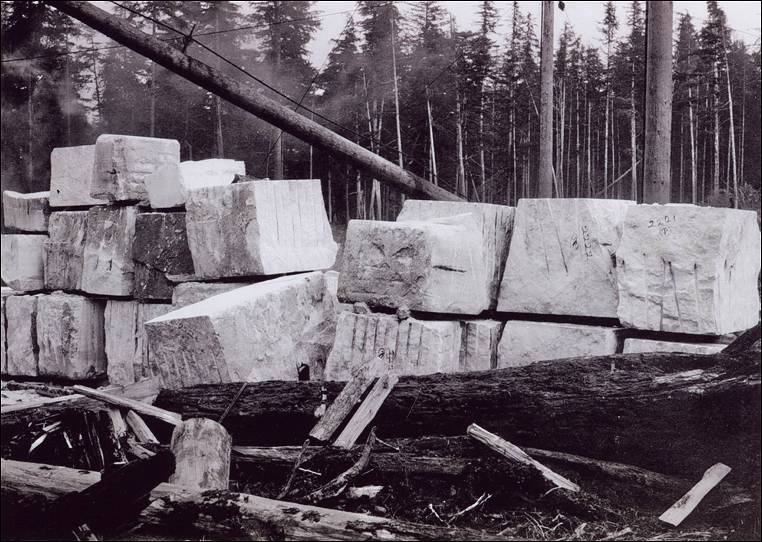|
From my big box of stupid, I pulled out Cremo and Thompson’s Forbidden Archaeology (1993; mine is the 1998 revised ed.), perhaps one of the worst offenders in the realm of stupid claims about archaeology. I can’t imagine how I managed to read through more than 800 pages of deathly-dull text when I was seventeen; apparently before cell phones and broadband I had a greater tolerance for longwinded boredom. At least Erich von Däniken managed to make his fraud and lies entertaining to read. Anyway, I opened the book at random, and the first thing I saw was from page 797, “Letters in Marble Block, Philadelphia,” which is as good an example as any of how Cremo and Thompson selectively reported bits of “evidence” to create false impressions in favor of Hindu creationism. Cremo and Thompson report an article from the American Journal of Science (vol. 19, 1831, p. 361) which describes a marble block from Norristown, Pennsylvania. When it was uncovered in a quarry in 1829 and cleaved in half, within were found a more or less geometric break line that gave the appearance of two letters. The earliest drawing of it, from April 1830, is below: The “engraving” measured 1.5 inches by 0.6 inches and was the only blemish in 18 square feet of rock surface. Surrounding the “letters” was a brownish-black powder that had prevented the marble from forming evenly around the raised indentations. While this drawing does not look terribly scientific, Cremo and Thompson present a false drawing of the rock imaginatively redrawn either for or from W. R. Corliss’s Ancient Man: A Handbook of Puzzling Artifacts (1978), which implies to me that Cremo and Thompson never read the original report, only Corliss’s summary of it. The Cremo and Thompson drawing is rougher and more detailed, made to look like an actual archaeological drawing, including the texture of the stone, but based on no actual original observation. Here is the Cremo and Thompson version: Corliss, a physicist, compiled anomalous material from scientific journals in his books. Arthur C. Clarke wrote that “Unlike Fort, Corliss selected his material almost exclusively from scientific journals like Nature and Science, not newspapers, so it has already been subjected to a filtering process which would have removed most hoaxes and reports from obvious cranks.” Clarke, however, was apparently unaware that early nineteenth century scientific journals did not have peer review, and many of their reports were simple letters asserting claims without verification. A later sketch, from May 1830, gives a slightly different look, with irregular lines rather than perfect geometrical lines and the letters in a completely different order. There was no real agreement on the artifact’s actual shape. Based on the depth at which the rock was quarried, its age was estimated at eight million years old in 1830, though Cremo and Thompson decline to date the rock. (Modern alternative authors have recently claimed 500 million years.) According to Cremo and Thompson, But does it? Ironically enough, the American Journal of Science report is dated April 1, 1830 but was mistakenly delayed in its publication because the editor had lost the letter. Had this been the only reference to the stone, I would willingly ascribe it to an April Fool’s prank, but it also appeared in the Pennsylvania Inquirer and the Pennsylvania Register. It is also worth noting that the journal’s notice is not in the form of a scientific article but a letter to the editor in the “Miscellanies” section at the close of the issue. Only a few years earlier, the editor of the American Journal of Science, Benjamin Silliman, fired the famed botanist C. S. Rafinesque, who would later go on to fake evidence for the Lost Race of Mound Builders, after a smear campaign by Caleb Atwater, who advocated for the acceptance of Hindus as the builders of America's ancient mounds, because Rafinesque had accused Atwater of plagiarism. Objectivity was not high on their list of virtues. Cremo and Thompson accurately report the contents of J. B. Browne’s letter to the editor, though they attribute the remarks to the Journal itself. But this is the extent of their investigation. A cursory examination of news reports from the spring of 1830 shows that “several of the most respectable gentlemen” whom Browne refers to were not of the opinion, shared by Browne, Corliss, Cremo, and Thompson that the imperfection in the marble was the work of human beings. The Register of Pennsylvania for April 1830 (vol. 5) presents the opinions of these respectable gentlemen, including the lawyer and amateur scientist Peter A. Browne, Esq.—whose relationship to J. B. Browne I do not know—which differ significantly from the Cremo and Thompson assumptions. Neither Joseph Thomas nor Benjamin Bartholomew, two of the “respectable gentlemen,” ventured an opinion on the indentation. They merely confirmed that it was present when the marble slab was cleaved open in November 1829 and had not been added later. Peter Browne gave the following account:
That, of course, means a “freak of nature.”
This is undoubtedly the right interpretation, but it was not the most popular in the 1830s. This was the period when the nation was transfixed by the idea that ancient Hebrews—the Lost Tribes of Israel—were the first settlers of America. As a result, nearly all the early interpretations of the find focused on whether they were Hebrew letters, thus proving the Lost Tribes theory. Several different Hebrew suggestions were made, including “Yahweh” and “Piety and Truth.” This would have been a tall order, since the square form Hebrew alphabet was scarcely two thousand years old—let alone eight million. This did not stop the Columbia Star and Christian Index from reporting in May 1830 that the find demonstrated “the truth of Scripture” through “real science,” though it did dutifully report that a real scientist—a Dr. Mitchell of New York—was fairly certain the impression was an accidental crystallization. Cremo and Thompson also fail to report that by the time of the compilation of Sherman Day’s Historical Collections of the State of Pennsylvania in 1843, the “freak of nature” hypothesis was uncontroversial enough that Day was able to claim the rock was little more than a lasus naturae without fear of contradiction. As an interesting side note, in 1878 residents of this same town were quite disappointed upon finding another buried carving—a sandstone bust of a man—because the image was obviously a Native American and not a Hebrew of the Lost Race. To conclude, here is a picture from c. 1910 of some quarried marble blocks in Alaska. As you can see, they are not the smooth, unblemished marble familiar from polished and finished construction. It is quite easy to see how blocks like these can contain imperfections, crystallization, or areas where the metamorphic action did not evenly apply throughout the limestone during its transformation.
2 Comments
William LaSalle
9/20/2015 11:56:35 pm
In Sanskrit Ni was another name for Num, the God of the Waters. (Sumerian).
Reply
It was ostensibly a hoax perpetrated by one Mr. Alexander Ramsey. He arguably knew the Hebrew letters Yood and Hay would be interpreted as the divine holy name. He likely purchased the 32 cubic foot marble block at the Henderson Quarry in Norristown PA in c. 1829 AD. He then had someone else split it into 2 slabs, have a tombstone engraver put the Hebrew characters in and then use mortar to reseal the two slabs. He then sanded it carefully to hide the dried mortar. Then he had it brought by horse drawn wagon to Savage's Sawmill also in Norristown area where he told the marble-cutter employees exactly where to cut it.The rest is history...
Reply
Your comment will be posted after it is approved.
Leave a Reply. |
AuthorI am an author and researcher focusing on pop culture, science, and history. Bylines: New Republic, Esquire, Slate, etc. There's more about me in the About Jason tab. Newsletters
Enter your email below to subscribe to my newsletter for updates on my latest projects, blog posts, and activities, and subscribe to Culture & Curiosities, my Substack newsletter.
Categories
All
Terms & ConditionsPlease read all applicable terms and conditions before posting a comment on this blog. Posting a comment constitutes your agreement to abide by the terms and conditions linked herein.
Archives
July 2024
|
- Home
- Blog
- Books
-
Articles
-
Newsletter
>
- Television Reviews >
- Book Reviews
- Galleries >
- Videos
-
Collection: Ancient Alien Fraud
>
- Chariots of the Gods at 50
- Secret History of Ancient Astronauts
- Of Atlantis and Aliens
- Aliens and Ancient Texts
- Profiles in Ancient Astronautics >
- Blunders in the Sky
- The Case of the False Quotes
- Alternative Authors' Quote Fraud
- David Childress & the Aliens
- Faking Ancient Art in Uzbekistan
- Intimations of Persecution
- Zecharia Sitchin's World
- Jesus' Alien Ancestors?
- Extraterrestrial Evolution?
- Collection: Skeptic Magazine >
- Collection: Ancient History >
- Collection: The Lovecraft Legacy >
- Collection: UFOs >
- Scholomance: The Devil's School
- Prehistory of Chupacabra
- The Templars, the Holy Grail, & Henry Sinclair
- Magicians of the Gods Review
- The Curse of the Pharaohs
- The Antediluvian Pyramid Myth
- Whitewashing American Prehistory
- James Dean's Cursed Porsche
-
Newsletter
>
-
The Library
-
Ancient Mysteries
>
-
Ancient Texts
>
- Mesopotamian Texts >
-
Egyptian Texts
>
- The Shipwrecked Sailor
- Dream Stela of Thutmose IV
- The Papyrus of Ani
- Classical Accounts of the Pyramids
- Inventory Stela
- Manetho
- Eratosthenes' King List
- The Story of Setna
- Leon of Pella
- Diodorus on Egyptian History
- On Isis and Osiris
- Famine Stela
- Old Egyptian Chronicle
- The Book of Sothis
- Horapollo
- Al-Maqrizi's King List
- Teshub and the Dragon
- Hermetica >
- Hesiod's Theogony
- Periplus of Hanno
- Ctesias' Indica
- Sanchuniathon
- Sima Qian
- Syncellus's Enoch Fragments
- The Book of Enoch
- Slavonic Enoch
- Sepher Yetzirah
- Tacitus' Germania
- De Dea Syria
- Aelian's Various Histories
- Julius Africanus' Chronography
- Eusebius' Chronicle
- Chinese Accounts of Rome
- Ancient Chinese Automaton
- The Orphic Argonautica
- Fragments of Panodorus
- Annianus on the Watchers
- The Watchers and Antediluvian Wisdom
-
Medieval Texts
>
- Medieval Legends of Ancient Egypt >
- The Hunt for Noah's Ark
- Isidore of Seville
- Book of Liang: Fusang
- Agobard on Magonia
- Book of Thousands
- Voyage of Saint Brendan
- Power of Art and of Nature
- Travels of Sir John Mandeville
- Yazidi Revelation and Black Book
- Al-Biruni on the Great Flood
- Voyage of the Zeno Brothers
- The Kensington Runestone (Hoax)
- Islamic Discovery of America
- The Aztec Creation Myth
-
Lost Civilizations
>
-
Atlantis
>
- Plato's Atlantis Dialogues >
- Fragments on Atlantis
- Panchaea: The Other Atlantis
- Eumalos on Atlantis (Hoax)
- Gómara on Atlantis
- Sardinia and Atlantis
- Santorini and Atlantis
- The Mound Builders and Atlantis
- Donnelly's Atlantis
- Atlantis in Morocco
- Atlantis and the Sea Peoples
- W. Scott-Elliot >
- The Lost Atlantis
- Atlantis in Africa
- How I Found Atlantis (Hoax)
- Termier on Atlantis
- The Critias and Minoan Crete
- Rebuttal to Termier
- Further Responses to Termier
- Flinders Petrie on Atlantis
- Amazing New Light (Hoax)
- Lost Cities >
- OOPARTs
- Oronteus Finaeus Antarctica Map
- Caucasians in Panama
- Jefferson's Excavation
- Fictitious Discoveries in America
- Against Diffusionism
- Tunnels Under Peru
- The Parahyba Inscription (Hoax)
- Mound Builders
- Gunung Padang
- Tales of Enchanted Islands
- The 1907 Ancient World Map Hoax
- The 1909 Grand Canyon Hoax
- The Interglacial Period
- Solving Oak Island
-
Atlantis
>
- Religious Conspiracies >
-
Giants in the Earth
>
-
Fossil Origins of Myths
>
- Fossil Teeth and Bones of Elephants
- Fossil Elephants
- Fossil Bones of Teutobochus
- Fossil Mammoths and Giants
- Giants' Bones Dug Out of the Earth
- Fossils and the Supernatural
- Fossils, Myth, and Pseudo-History
- Man During the Stone Age
- Fossil Bones and Giants
- Mastodon, Mammoth, and Man
- American Elephant Myths
- The Mammoth and the Flood
- Fossils and Myth
- Fossil Origin of the Cyclops
- History of Paleontology
- Fragments on Giants
- Manichaean Book of Giants
- Geoffrey on British Giants
- Alfonso X's Hermetic History of Giants
- Boccaccio and the Fossil 'Giant'
- Book of Howth
- Purchas His Pilgrimage
- Edmond Temple's 1827 Giant Investigation
- The Giants of Sardinia
- Giants and the Sons of God
- The Magnetism of Evil
- Tertiary Giants
- Smithsonian Giant Reports
- Early American Giants
- The Giant of Coahuila
- Jewish Encyclopedia on Giants
- Index of Giants
- Newspaper Accounts of Giants
- Lanier's A Book of Giants
-
Fossil Origins of Myths
>
-
Science and History
>
- Halley on Noah's Comet
- The Newport Tower
- Iron: The Stone from Heaven
- Ararat and the Ark
- Pyramid Facts and Fancies
- Argonauts before Homer
- The Deluge
- Crown Prince Rudolf on the Pyramids
- Old Mythology in New Apparel
- Blavatsky on Dinosaurs
- Teddy Roosevelt on Bigfoot
- Devil Worship in France
- Maspero's Review of Akhbar al-zaman
- The Holy Grail as Lucifer's Crown Jewel
- The Mutinous Sea
- The Rock Wall of Rockwall
- Fabulous Zoology
- The Origins of Talos
- Mexican Mythology
- Chinese Pyramids
- Maqrizi's Names of the Pharaohs
-
Extreme History
>
- Roman Empire Hoax
- American Antiquities
- American Cataclysms
- England, the Remnant of Judah
- Historical Chronology of the Mexicans
- Maspero on the Predynastic Sphinx
- Vestiges of the Mayas
- Ragnarok: The Age of Fire and Gravel
- Origins of the Egyptian People
- The Secret Doctrine >
- Phoenicians in America
- The Electric Ark
- Traces of European Influence
- Prince Henry Sinclair
- Pyramid Prophecies
- Templars of Ancient Mexico
- Chronology and the "Riddle of the Sphinx"
- The Faith of Ancient Egypt
- Remarkable Discoveries Within the Sphinx (Hoax)
- Spirit of the Hour in Archaeology
- Book of the Damned
- Great Pyramid As Noah's Ark
- Richard Shaver's Proofs
-
Ancient Texts
>
-
Alien Encounters
>
-
US Government Ancient Astronaut Files
>
- Fortean Society and Columbus
- Inquiry into Shaver and Palmer
- The Skyfort Document
- Whirling Wheels
- Denver Ancient Astronaut Lecture
- Soviet Search for Lemuria
- Visitors from Outer Space
- Unidentified Flying Objects (Abstract)
- "Flying Saucers"? They're a Myth
- UFO Hypothesis Survival Questions
- Air Force Academy UFO Textbook
- The Condon Report on Ancient Astronauts
- Atlantis Discovery Telegrams
- Ancient Astronaut Society Telegram
- Noah's Ark Cables
- The Von Daniken Letter
- CIA Psychic Probe of Ancient Mars
- Scott Wolter Lawsuit
- UFOs in Ancient China
- CIA Report on Noah's Ark
- CIA Noah's Ark Memos
- Congressional Ancient Aliens Testimony
- Ancient Astronaut and Nibiru Email
- Congressional Ancient Mars Hearing
- House UFO Hearing
- Ancient Extraterrestrials >
- A Message from Mars
- Saucer Mystery Solved?
- Orville Wright on UFOs
- Interdimensional Flying Saucers
- Poltergeist UFOs
- Flying Saucers Are Real
- Report on UFOs
-
US Government Ancient Astronaut Files
>
-
The Supernatural
>
- The Devils of Loudun
- Sublime and Beautiful
- Voltaire on Vampires
- Demonology and Witchcraft
- Thaumaturgia
- Bulgarian Vampires
- Religion and Evolution
- Transylvanian Superstitions
- Defining a Zombie
- Dread of the Supernatural
- Vampires
- Werewolves and Vampires and Ghouls
- Science and Fairy Stories
- The Cursed Car
-
Classic Fiction
>
- Lucian's True History
- Some Words with a Mummy
- The Coming Race
- King Solomon's Mines
- An Inhabitant of Carcosa
- The Xipéhuz
- Lot No. 249
- The Novel of the Black Seal
- The Island of Doctor Moreau
- Pharaoh's Curse
- Edison's Conquest of Mars
- The Lost Continent
- Count Magnus
- The Mysterious Stranger
- The Wendigo
- Sredni Vashtar
- The Lost World
- The Red One
- H. P. Lovecraft >
- The Skeptical Poltergeist
- The Corpse on the Grating
- The Second Satellite
- Queen of the Black Coast
- A Martian Odyssey
- Classic Genre Movies
-
Miscellaneous Documents
>
- The Balloon-Hoax
- A Problem in Greek Ethics
- The Migration of Symbols
- The Gospel of Intensity
- De Profundis
- The Life and Death of Crown Prince Rudolf
- The Bathtub Hoax
- Crown Prince Rudolf's Letters
- Position of Viking Women
- Employment of Homosexuals
- James Dean's Scrapbook
- James Dean's Love Letters
- The Amazing James Dean Hoax!
- James Dean, The Human Ashtray
- Free Classic Pseudohistory eBooks
-
Ancient Mysteries
>
- About Jason
- Search
© 2010-2024 Jason Colavito. All rights reserved.










 RSS Feed
RSS Feed
